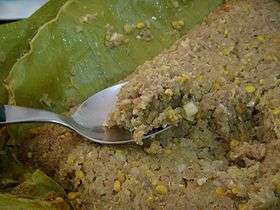Prahok

Prahok (ប្រហុក) is a crushed, salted and fermented fish paste (usually of mudfish) that is used in Cambodian cuisine as a seasoning or a condiment.[1] It originated as a way of preserving fish during the months when fresh fish was not available in abundant supply. Because of its saltiness and strong flavor, it was used as an addition to many meals in Cambodian cuisine, such as soups and sauces. A Cambodian saying goes, "No prahok, no salt", referring to a dish that is of poor flavor or bland thus highlighting its essentiality in Cambodian cuisine. Prahok has a strong and distinct smell, earning the nickname "Cambodian cheese" among food writers.[2] Prahok is usually eaten as a main course with white rice and vegetable such as yardlong bean, cucumbers, and Thai eggplant.
Because it is easily stored and preserved, Prahok is sometimes distributed as a donation to victims of flood or drought by charities and other organizations. It can be eaten cooked or fried, but is usually not eaten raw because of health issues (raw Prahok cannot be stored long due to spoilage if not consumed in a short period) and the unpleasant smell it makes.
Varieties and production
Prahok is made with various fish and methods of fermented. Fish used include mudfish (Channa spp.) and moonlight gourami (Trichogaster microlepis). One noted variety made with a gourami species is called Prahok Kanthara and is attributed to a Laotian style of preparation.
Prahok is obtained by crushing or grinding fresh fish after de-scaling, gutting and cleaning them. They can be crushed underfoot, like wine grapes, or processed by machine. After the fish is crushed, it is left in the sun for a full day, then salted. The prahok is fermented in large clay jars covered with a lid made of woven bamboo strips. Afterwards, the prahok can be eaten just 20 days of fermentation, but better quality Prahok is left to ferment longer, up to three years.
Prahok is also produced in Vietnam and imported for Cambodian diaspora United States.
Prahok dishes

Prahok can be prepared and served in several different ways. Below are dishes where prahok is a main component.
Fried prahok
Prahok chien (ប្រហុកជៀន) It is usually mixed with meat (usually beef or pork) and chili peppers. It can also be eaten as a dip, accompanied by vegetables like cucumbers or eggplants, and rice.
Covered prahok
Prahok Kob or Prahok aing (ប្រហុកកប់) or (ប្រហុកអាំង) This type of prahok is covered with banana leaves and left to cook under pieces of rock beneath a fire or over the coals.
Raw prahok
Prahok chao (ប្រហុកឆៅ) This type of prahok can be used to make a paste with lemon grass, lime juice, fresh peppers, and eggplant eaten with (usually cooked rare) beef steak. Also this is the type of prahok preferably used as a dipping paste for vegetables and fruits.[1]
See also
- Shrimp paste, similar fermented shrimp paste common in Southeast Asia
- Ngapi, Burmese fish paste
- Bagoong, Filipino fish paste
References
- 1 2 Prahok Just another wordpress weblong Prahok Accessed July 22, 2007
- ↑ Star Chefs Five main Cambodian ingredients Accessed July 21, 2007
External links
- LeisureCambodia.com - The Story of Prahok article.
- ThingsAsian.com - Got fish? It's Prahok season in Cambodia article.

